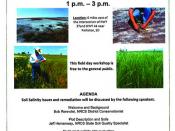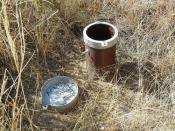"Salinity is the presence of salt in the land surfaces, in soil or rock, or dissolved in water in our rivers or groundwater".
Salt naturally occurs in many parts of Australia's Landscape. It has been in the soil since well before farming began. Most of the salt is sodium chloride (NaCl), which is table salt, however there are also varying amounts of other salts present such as: sodium bicarbonate (NaHSO4: baking soda), sodium sulphate (Na2SO4: soda ash), magnesium sulphate (MgSO4: Epsom salts), and calcium sulphate (CaSO4: gypsum).
The origins of these salts can be linked to:
oPrehistoric marine or riverine sediments2
oThe weathering or breakdown of the rocks that make up local soils2
oSalts carried inland from costal areas by strong winds2
Over time, the European style farming method has significantly altered the landscape and upset the natural water balance.2 In many of these landscapes the water table is rising.
This is due to the presence of more groundwater, caused by the extra rainwater seeping down from the surface as a result of the clearing of native vegetation.
Dryland salinity occurs when native vegetation is cleared and replaced with crops and pastures that have shallower roots and require less water. Before clearing, the native vegetation would use most of the water from rainfall, and therefore only a small amount would enter the groundwater system, however crops and pastures use significantly less water than native plants so more water seeps into the groundwater causing the water table to rise.1
Ground water is saline as it carries dissolved salts from the soil and bedrock material that it travels through.1 Over time the saline ground water rises to near the surface in low-lying areas.3 Salt enters the plant root zone once ground water comes within 2 meters of the soils surface.


